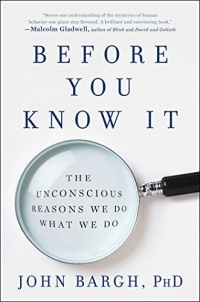John Bargh
James Rowland Angell
Professor of Psychology at Yale University, where he directs the ACME
(Automaticity in Cognition Motivation and Evaluation) laboratory.
https://greatergood.berkeley.edu/article/item/how_to_use_your_unconscious_mind_to_achieve_your_goals
The most effective way to change your behavior for the better is to work in tandem with your unconscious mind.
(You still have problem with your financial? May be this is a solution
It’s the end of January. How many of us made New Year’s
resolutions this year, but have already broken them? Maybe we told
ourselves we’ll exercise more, or spend more time with our children, or
not get so angry all the time. But we’re no closer to these goals than
we were before.
It turns out that part of the problem is the way we make these
resolutions: They rely on our conscious decision-making processes. We
just set a good intention to do things differently, and we leave it at
that. But experience should tell us that good intentions are often not
enough.
 In my new book, Before You Know It,
I present all the ways our personal ship of good intentions can get
blown off course by the powerful unconscious motivations and environmental cues
that also influence what we do. Because we are not aware of these
unconscious influences, we do nothing to counteract them. Yet they are
like the currents and winds that affect a ship’s course just as much as
the captain’s rudder. Ignore them, and you may drift further out to
sea—or crash into the rocks.
In my new book, Before You Know It,
I present all the ways our personal ship of good intentions can get
blown off course by the powerful unconscious motivations and environmental cues
that also influence what we do. Because we are not aware of these
unconscious influences, we do nothing to counteract them. Yet they are
like the currents and winds that affect a ship’s course just as much as
the captain’s rudder. Ignore them, and you may drift further out to
sea—or crash into the rocks.
The first question to ask yourself when a resolution is failing is: Do I really want to change? If you are honest with yourself, maybe down deep you actually want to keep drinking, or overeating, or not exercising. And those “wants” are going to override the good intentions of your resolutions.
There was a famous experiment done at Princeton many years ago with divinity students—highly moral and compassionate individuals. They were supposed to give a sermon in their next class, but the experimenters intentionally made them late; they had to hurry to be on time. Along the way, a person lay in distress in the hallway, but the late students rushed right by and didn’t help. Their goal to get to the next class on time overrode their own personal values, and they failed to act on those values and help the person in need. Ironically, the topic of the sermon they were to deliver was the Good Samaritan parable from the Bible.
The same thing can happen to you and me. Despite our values and intentions, we may have some other goal that conflicts with our new resolution. And if our resolution is something that, down deep, we don’t really want to change, our conscious mind is very adept at coming up with convenient excuses and rationalizations. “Hey, I’ll start that new diet tomorrow.” And then that tomorrow never comes.
So ask yourself if you are truly committed to change. Only if the answer is “yes” can you overcome those powerful winds and currents that can drive you off course.
Another surprisingly powerful influence on what we do comes from environmental cues that trigger behaviors unconsciously, without our realizing it. The behavior of others, for example, is quite contagious, and we can “catch” it through our daily contact with other people and even through social media.
If our Facebook network connects us to overweight, depressed, lonely, cooperative, or happy individuals, even if we don’t know or interact with them personally, we ourselves are more likely to be those things, too. And TV and other media ads affect us in the same way: We tend to eat more when we see food ads, and teenagers tend to drink more alcohol the more alcohol ads they see.
By acknowledging these unconscious influences on us, we actually increase the amount of free will that we have. If we deny these effects exist, then we are at their mercy and have less actual control than we think. But what’s even better is that once we know how they work, we can turn these unconscious forces to our own advantage.
Decades of laboratory research as well as practical demonstrations in real-life settings have revealed the power of conscious “implementation intentions.” How do they work?
They often take the form of “When X happens, I will do Y.” You make a clear, concrete plan that includes where, when, and how you will carry out the intention. You tie your desired future behavior to a highly likely event or situation. Then when that future event actually happens, you will more often than not find yourself starting to do the very thing you wanted to do, even if you’d forgotten you wanted to do it.
 This essay is adapted from Before You Know It: The Unconscious Reasons We Do What We Do (Touchstone, 2017, 352 pages).
I used this technique myself to block the carryover
effects of a bad day at work. First, I set an intention—to let go of the
negative stresses of work when I get home and show my family I am happy
to be with them. Then, I came up with an implementation plan, which I
tied to a reliable future event: The moment when I get out of my car
after driving home from work, and am standing in my driveway (that’s the
when and where), I remind myself to take a deep breath, forget all about the office, and be happy to be home with my family (that’s the how). After I did this for about a week, it started to become a new habit that I carry on to this day.
This essay is adapted from Before You Know It: The Unconscious Reasons We Do What We Do (Touchstone, 2017, 352 pages).
I used this technique myself to block the carryover
effects of a bad day at work. First, I set an intention—to let go of the
negative stresses of work when I get home and show my family I am happy
to be with them. Then, I came up with an implementation plan, which I
tied to a reliable future event: The moment when I get out of my car
after driving home from work, and am standing in my driveway (that’s the
when and where), I remind myself to take a deep breath, forget all about the office, and be happy to be home with my family (that’s the how). After I did this for about a week, it started to become a new habit that I carry on to this day.
Or, what if you want to start exercising, but keep forgetting to? One idea is to make an implementation intention: When you go into your bedroom (that’s the where) to change out of your work clothes, you will immediately put on your running clothes and shoes (that’s the how). Once you do that, you’d look pretty silly if you didn’t go out for a run, right?
Implementation intentions have had great practical success, such as helping nursing home residents to take their many medications, on which their lives can depend, without fail over a long period of time. And they’ve helped people to keep on track with their goals, even when facing interruptions or negative influence from others.
The other side of the same coin works for unwanted behaviors. The latest research on self-control has actually shown that people who have the most self-control—who in fact tend to be happier and healthier, make more money, have more friends, and be more successful in life than the rest of us—are not those with the strongest willpower. They are those who set up their personal worlds to remove cues to unwanted behaviors, preventing the temptation from happening in the first place. So, just don’t buy that bottle of wine or yummy dessert. It won’t be there at home in the evening to tempt you.
This trick can also work at the societal level. Self-control researcher Wendy Wood has pointed out that the great reduction in smoking that we have achieved over the past 30 years was accomplished not through people using willpower, but mainly through smoking bans, taxes, eliminating cigarette and tobacco ads from TV and magazines, and forbidding cigarette displays in stores. Getting rid of the environmental cues to smoke helped those who wanted to quit far more than other factors.
This new scientific evidence should give us hope. If we want to increase good habits, we can tie them to a regular place and time and give ourselves reminders to prime our unconscious mind to support these habits. If we want to rid ourselves of certain habits, we can remove cues and opportunities from our environment, and replace our unconscious impulses with positive, conscious messages.
In this way, we can use the power of our unconscious mind for good…and have a much better chance of keeping those New Year’s resolutions.

The first question to ask yourself when a resolution is failing is: Do I really want to change? If you are honest with yourself, maybe down deep you actually want to keep drinking, or overeating, or not exercising. And those “wants” are going to override the good intentions of your resolutions.
There was a famous experiment done at Princeton many years ago with divinity students—highly moral and compassionate individuals. They were supposed to give a sermon in their next class, but the experimenters intentionally made them late; they had to hurry to be on time. Along the way, a person lay in distress in the hallway, but the late students rushed right by and didn’t help. Their goal to get to the next class on time overrode their own personal values, and they failed to act on those values and help the person in need. Ironically, the topic of the sermon they were to deliver was the Good Samaritan parable from the Bible.
The same thing can happen to you and me. Despite our values and intentions, we may have some other goal that conflicts with our new resolution. And if our resolution is something that, down deep, we don’t really want to change, our conscious mind is very adept at coming up with convenient excuses and rationalizations. “Hey, I’ll start that new diet tomorrow.” And then that tomorrow never comes.
So ask yourself if you are truly committed to change. Only if the answer is “yes” can you overcome those powerful winds and currents that can drive you off course.
Another surprisingly powerful influence on what we do comes from environmental cues that trigger behaviors unconsciously, without our realizing it. The behavior of others, for example, is quite contagious, and we can “catch” it through our daily contact with other people and even through social media.
If our Facebook network connects us to overweight, depressed, lonely, cooperative, or happy individuals, even if we don’t know or interact with them personally, we ourselves are more likely to be those things, too. And TV and other media ads affect us in the same way: We tend to eat more when we see food ads, and teenagers tend to drink more alcohol the more alcohol ads they see.
By acknowledging these unconscious influences on us, we actually increase the amount of free will that we have. If we deny these effects exist, then we are at their mercy and have less actual control than we think. But what’s even better is that once we know how they work, we can turn these unconscious forces to our own advantage.
Decades of laboratory research as well as practical demonstrations in real-life settings have revealed the power of conscious “implementation intentions.” How do they work?
They often take the form of “When X happens, I will do Y.” You make a clear, concrete plan that includes where, when, and how you will carry out the intention. You tie your desired future behavior to a highly likely event or situation. Then when that future event actually happens, you will more often than not find yourself starting to do the very thing you wanted to do, even if you’d forgotten you wanted to do it.
 This essay is adapted from Before You Know It: The Unconscious Reasons We Do What We Do (Touchstone, 2017, 352 pages).
This essay is adapted from Before You Know It: The Unconscious Reasons We Do What We Do (Touchstone, 2017, 352 pages).
Or, what if you want to start exercising, but keep forgetting to? One idea is to make an implementation intention: When you go into your bedroom (that’s the where) to change out of your work clothes, you will immediately put on your running clothes and shoes (that’s the how). Once you do that, you’d look pretty silly if you didn’t go out for a run, right?
Implementation intentions have had great practical success, such as helping nursing home residents to take their many medications, on which their lives can depend, without fail over a long period of time. And they’ve helped people to keep on track with their goals, even when facing interruptions or negative influence from others.
The other side of the same coin works for unwanted behaviors. The latest research on self-control has actually shown that people who have the most self-control—who in fact tend to be happier and healthier, make more money, have more friends, and be more successful in life than the rest of us—are not those with the strongest willpower. They are those who set up their personal worlds to remove cues to unwanted behaviors, preventing the temptation from happening in the first place. So, just don’t buy that bottle of wine or yummy dessert. It won’t be there at home in the evening to tempt you.
This trick can also work at the societal level. Self-control researcher Wendy Wood has pointed out that the great reduction in smoking that we have achieved over the past 30 years was accomplished not through people using willpower, but mainly through smoking bans, taxes, eliminating cigarette and tobacco ads from TV and magazines, and forbidding cigarette displays in stores. Getting rid of the environmental cues to smoke helped those who wanted to quit far more than other factors.
This new scientific evidence should give us hope. If we want to increase good habits, we can tie them to a regular place and time and give ourselves reminders to prime our unconscious mind to support these habits. If we want to rid ourselves of certain habits, we can remove cues and opportunities from our environment, and replace our unconscious impulses with positive, conscious messages.
In this way, we can use the power of our unconscious mind for good…and have a much better chance of keeping those New Year’s resolutions.


 © jonapotkivanunk.hu
© jonapotkivanunk.hu







 © richiesd
© richiesd







